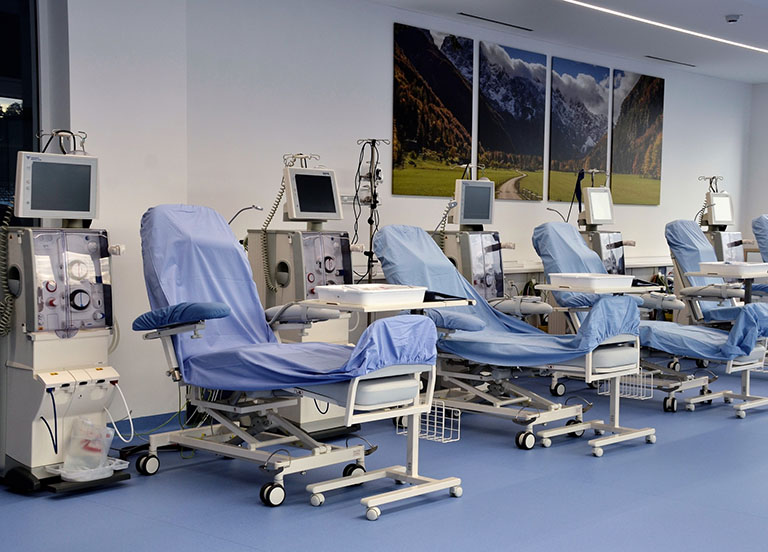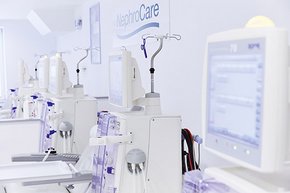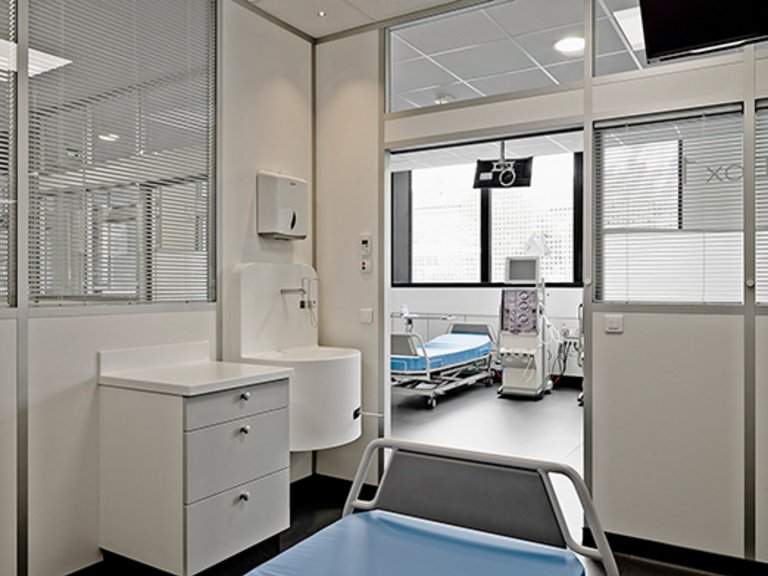Therapeutic apheresis is an extracorporeal blood purification procedure.
Dialysis care
Home Haemodialysis represents an alternative to in-center treatment since it provides higher flexibility in the treatment schedule and treatment frequency. However, the patient’s care team continues to support with check.
Shared and self-Care of patients in a dialysis center represents the equivalent level of independency in the treatment as home haemodialysis. The key to shared and self-Care is the involvement of the patient into the treatment at most or all steps.
Shared care is an important part of how we operate. We believe that for some, shared care actively encourages and empowers patients in the participation of their treatment building confidence in meeting their individual health care needs. Our shared care approach is built on reflecting the needs and preferences of patients, their families and carers. To offer patients choice and feel they have autonomy within their own care our nurses are highly trained to support patients who opt for a shared care approach to their treatment.
In-patient dialysis patients represent a mixed population from critical clinical status patients to those who are more autonomous, temporarily in the hospital environment for reasons not directly linked to their dialysis status. Dialysis treatments are performed in a dialysis unit within the hospital.
High-Flux dialysis
The essential element of High Flux Dialysis is the use of dialysers that have larger pores for the removal of both uraemic toxins and fluid. In conventional dialysis waste products and electrolytes are removed from the patient’s blood by diffusion – the movement of solutes from a solution of higher concentration (blood) to one of lower concentration (the dialysate) across a semipermeable membrane. Blood urea nitrogen (BUN) is measured and followed as a reflection of all the toxins that the kidney normally removes. With High Flux Dialysis, BUN is clearly removed more quickly. Larger molecules are too big to be removed by conventional dialysis, but are removed with high flux dialysers.
HighVolumeHDF
HighVolumeHDF with its numerous positive effects on dialysis-related cardiovascular risk factors is acknowledged as the most effective dialysis treatment modality 1 , coming closer to the elimination profile of the natural kidney.
By achieving high substitution volumes, HighVolumeHDF therapy is credited with more effective elimination of middle molecules. HighVolumeHDF improves patient outcomes and exerts beneficial effects on the main cardiovascular risk factors:
- Serum ß2-microglobulin and phosphate level 2,3,4
- Inflammatory response 5
- Intradialytic haemodynamic stability6
- Anaemia control7
Vascular Access Management
Vascular access is frequently referred to as the ‘patient lifeline’. Given the vital importance of this topic NephroCare has developed numerous tools and services focusing on the management and care of vascular access. More than a decade of experience in our NephroCare clinics has given us a high level of renal care expertise which we constantly reinvest in the NephroCare network in the form of guidelines and best practice approaches enriched and guided by NephroCare services and tools.
Supporting Vascular Access Management at clinic level
To support the easy connection and disconnection of patients in line with the NephroCare Standard Good Dialysis Care and NephroCare Guideline Hygiene and Infection Control requirements the proHD Set as well as the proHD CVC Set have been developed in our clinics.
The dedicated expertise inside our NephroCare network contributes to further best practice knowledge in the vascular access field.
Joint publication projects between Fresenius Medical Care and EDTNA/ ERCA:
- “Vascular Access Cannulation and Care Guide - A Nursing Best Practice Guide for Arteriovenous Fistula”
- “Vascular Access Management and Care - A Nursing Best Practice Guide for Central Venous Catheter”
Endovascular Services and Vascular Access Surgeries
NephroCare provides high levels of expertise for the development and management of Vascular Access Centres (VAC) which perform endovascular services and vascular access surgery.
Monitoring Vascular Access Achievements
Vascular Access Management is an integral part of NephroCare and contributes to the optimisation of CKD therapies to improve patient outcomes, which is managed through target agreements for dedicated Key Performance Indicators which are monitored through the Balanced ScoreCard.
Peritoneal Dialysis
Different prescriptions on PD, depending on lifestyle and medical condition
Continuous Ambulatory
Peritoneal dialysis performed in our NC clinics
- Regularly during the day
- 4 to 5 exchanges a day
- Exchange takes about 20-30 minutes
Automated Peritoneal dialysis performed at patient‘s home
- Approximately 8 - 10 hours
Cycler drains and refills peritoneal cavity automatically
REFERENCES
1 Canaud B., The Early Years of On- Line HDF: How Did It All Start? How Did We Get Here?, Krick G, Ronco C (eds): On- Line Hemodiafiltration: The Journey and the Vision, Contrib Nephrol, Basel, Karger (2011); 175: 93–109.
2 Canaud B., Effect of Online Hemodiafiltration on Morbidity and Mortality of Chronic Kidney Disease Patients, Ronco C, Canaud B, Aljama P (eds): Hemodiafiltration, Contrib Nephrol, Basel, Karger (2007); 158: 216-224.
3 Penne E.L. et al., Role of Residual Kidney Function and Convective Volume on Change in Beta2-Microglobulin Levels in Hemodiafiltration Patients, Clin J Am Soc Nephrol (2010); 5: 80-86.
4 Davenport A. et al., The effect of dialysis modality on phosphate control: haemodialysis compared to haemodiafiltration. The Pan Thames Renal Audit, Nephrol Dial Transplant (2010); 25(3): 897-901
5 Pedrini L. et al., Long-term effects of high-efficiency on-line haemodiafiltration on uraemic toxicity. A multicentre prospective randomized study, Nephrol Dial Transplant (2011); 0: 1-8
6 Locatelli F. et al., Hemofiltration and Hemodiafiltration Reduce Intradialytic Hypotension in ESRD, J Am Soc Nephrol (2010); 21(10): 1798–1807.
7 Bonforte G. et al.,Improvement of Anemia in Hemodialysis Patients Treated by Hemodiafiltration with High-Volume On-Line-Prepared Substitution Fluid, Blood Purif (2002); 20: 357–363.




